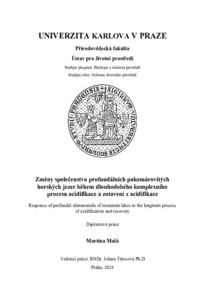Změny společenstva profundálních pakomárovitých horských jezer během dlouhodobého komplexního procesu acidifikace a zotavení z acidifikace
Response of profundal chironomids of mountain lakes to the lonngterm complex process of acidification and recovery
diploma thesis (DEFENDED)

View/
Permanent link
http://hdl.handle.net/20.500.11956/193899Identifiers
Study Information System: 146242
Collections
- Kvalifikační práce [21475]
Author
Advisor
Referee
Hamerlík, Ladislav
Faculty / Institute
Faculty of Science
Discipline
Environmental Protection
Department
Institute for Environmental Studies
Date of defense
4. 9. 2024
Publisher
Univerzita Karlova, Přírodovědecká fakultaLanguage
Czech
Grade
Excellent
Antropogenní acidifikace a následné zotavování povrchových vod byla v minulém století velmi dobře popsaný a dlouhodobě sledovaný proces, zejména v lidskou činností neovlivněných horských oblastech s kyselým podložím a slabě vyvinutými půdami, jež byly na acidifikaci nejcitlivější. Vysoké Tatry proto patřily v minulosti mezi nejsilněji zasažené evropské lokality a acidifikace zde měla nepřímo vliv i na druhové složení litorálních a profundálních pakomárovitých. Nepřímo proto, že hlavním hybatelem posunu v druhovém složení pakomárů byla změna v dostupnosti živin a jejich toku z povodí, v důsledku precipitace fosforu s Al-komplexy (oligotrofizace acidifikovaných jezer) či naopak uvolňování fosforu z těchto vazeb (eutrofizace silně acidifikovaných jezer) v závislosti na pH vody a půdy v povodí. V souvislosti s biologickým recovery se v roce 2011 očekáváný nárůst abundance v původně acidifikovaných jezerech, která se chemicky posunula mezi neacidifikovaná, nepotvrdil a celková abundance proti stavu na konci 80. let klesla. Očekávané osídlení novými druhy se však potvrdilo. Silně acidifikovaná jezera reagovala během procesu recovery různě: byl potvrzen očekávaný pokles celkové abundance, nicméně trendy v druhovém složení i v počtu taxonů se u jezer této kategorie velmi lišily. Překvapivě tato skupina...
Anthropogenic acidification and the subsequent recovery of surface waters has been a well-described and long-monitored process over the past century, especially in remote mountain areas with acidic bedrock and poorly developed soils sensitive to acidification. Therefore, The High Tatra Mts. were the most heavily affected European sites, and acidification indirectly affected the species composition of littoral and profundal chironomids. The main driver of the shift in the chironomid species composition was the change in nutrient availability and its flux from the catchment due to the precipitation of phosphorus with Al-complexes (oligotrophication of acidified lakes) or, conversely, the release of phosphorus from these bonds (eutrophication of strongly acidified lakes) depending on the pH of the water and soils in the catchment. In the context of biological recovery in 2011, the expected increase in total abundance in acidified lakes (that already chemically met the criteria of non-acidified lakes) was not confirmed since total abundance declined relative to the late 1980s. However, the expected inhabitation by new taxa has been observed. Strogly acidified lakes reacted differently during the recovery process: the expected decrease in total abundance was confirmed, but trends in species composition...
